San Jose, with its mix of green spaces and urban structures, is home to a wide range of spider species. They can be found everywhere, from gardens and mountains to the nooks of towering buildings. While their appearance may surprise and frighten some, spiders are important for keeping our ecosystem in check by managing insect numbers.
For those living in or visiting the city, discovering the various spiders in and around San Jose can be an eye-opener to the local wildlife diversity. Let’s dive into the world of San Jose’s venomous and non-venomous spiders and learn how to identify them! That way, the next time you spot a spider in the area, you’ll be able to confidently say what kind it is and whether you should steer clear of it!
Venomous Spiders in San Jose
Look out for the following spiders in San Jose. They all are venomous!
1. Western Black Widow (Latrodectus hesperus)
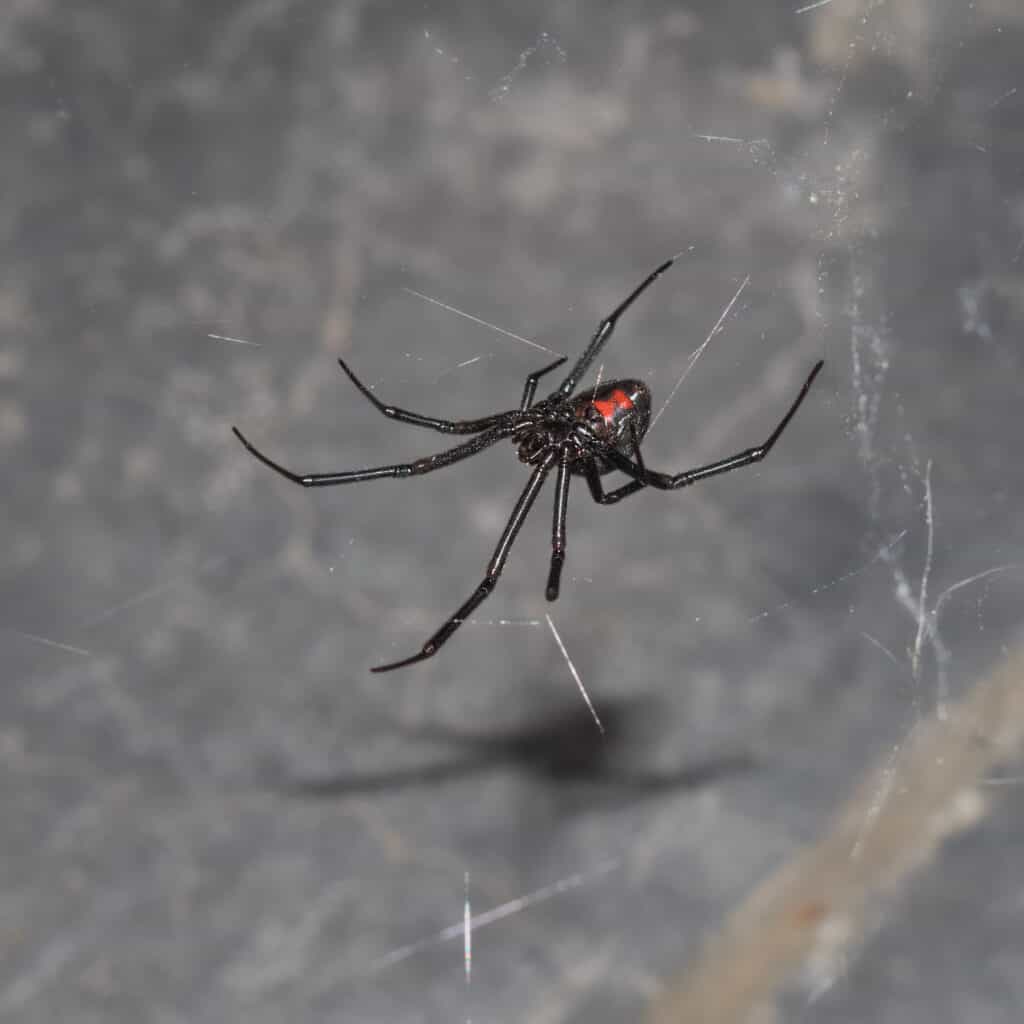
Of course, the most notable feature of the western black widow is the red hourglass-like shape on its abdomen.
©iStock.com/Shravan Sundaram Photography
The western black widow is a venomous member of the spider community in San Jose and belongs to the widely recognized black widow family in North America.
Adult female western black widows measure roughly ½ inch in body size, showcasing a distinct appearance. Their entire body and legs glisten in a deep black shade. Also, notably, this spider sports a red hourglass-like design on its belly’s underside.
In contrast, male western black widows are noticeably smaller than their female counterparts, measuring between 1/10 to 1/4 inch. They have a lighter coloring, either brown or gray, with striped legs. Though they also have the unique hourglass marking beneath their belly, it is often orange or yellow, not red.
The western black widow diet mainly consists of insects, but these spiders are also known to consume diplopods, woodlice, chilopods, and even other spiders. As evidenced by their name, females sometimes eat male black widows when food becomes scarce.
These spiders prefer locations like wood stacks and occasionally make their way indoors via firewood. They are fond of dim, dry hiding spots, making eaves, boxes, gaps made by rodents, cellars, sheds, neglected blankets and footwear, and gaps in patios or decks in their chosen residences.
The western black widow is one of the most venomous spiders in San Jose. The venom of the black widow spider targets the nervous system. While some individuals might experience mild reactions, others can have more severe responses.
2. Noble False Widow (Steatoda grossa)

The noble false widow spider is one of the most dangerous spiders in San Jose, as it carries harmful venom
©JorgeOrtiz_1976/Shutterstock.com
The Steatoda nobilis spider, first spotted in California in 2011, eventually established itself in San Jose. This European-origin spider, commonly mistaken for the false black widow, is among the top invasive spider species around the world.
Distinguishing features of these spiders include an abdomen pattern that, while some liken to a skull, more closely looks like a pentagon. This design is more evident in male spiders and can be lighter or even non-existent in females. With legs of a consistent reddish-brown shade, adult females can grow up to 5/8 inch, making them significantly larger than their false black widow counterparts.
The noble false widow‘s dietary habits are quite diverse, encompassing everything from woodlice, flies, and centipedes to even wasps and bees. Notably, they’ve been known to tackle larger prey like lizards, bats, and shrews.
They are commonly found within households and other buildings, particularly favoring elevated areas like the topmost corners of rooms or within sunrooms, serving as vantage points to catch flying insects.
The debate over the potential harm from this spider’s bite has persisted among experts for years. Current research suggests that some reactions to their bites can be similar to those of the actual black widow, with extreme cases leading to a hospital stay.
3. Desert Recluse (Loxosceles deserta)
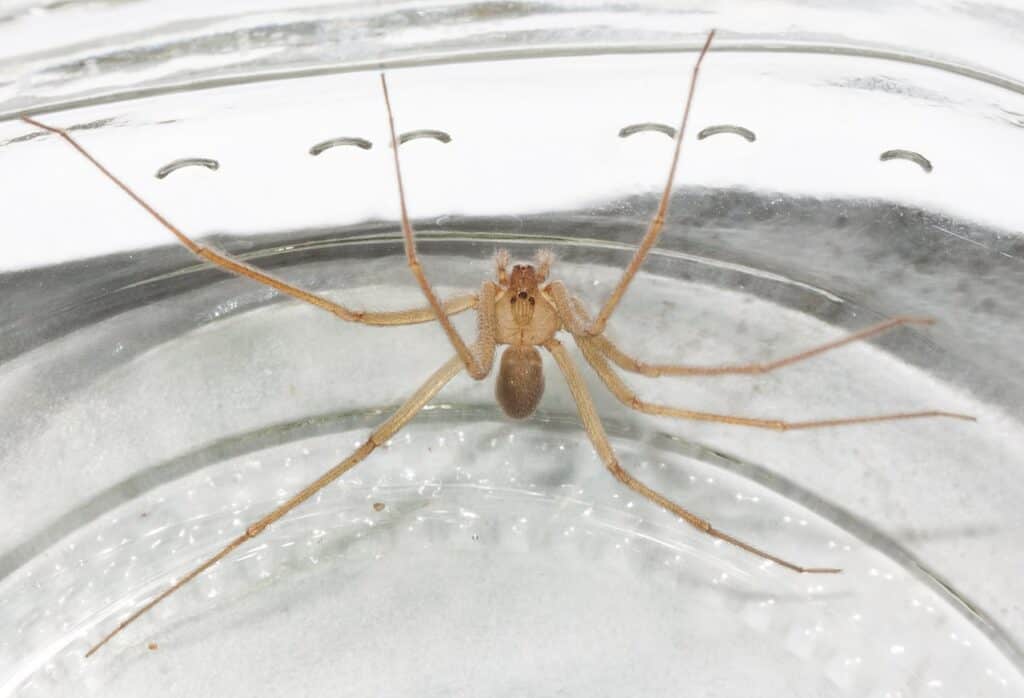
The desert recluse is a light to deep-brown recluse spider that may bite if it feels cornered or threatened!
©DesertTrip / CC BY-SA 4.0, via Wikimedia Commons – License
While California isn’t home to the brown recluse, it does host four species of recluse spiders, with the desert recluse being the most commonly found among them.
These spiders display a hue ranging from light to deep brown, possess notably long and sleek legs, and even with their legs fully extended, they seldom exceed a diameter of 1.5 to 2 inches. The front part of their body has a rounded shape, while their abdomen is slimmer, adorned with short, fine hairs, giving it a matte finish.
Their diet is versatile, feeding on almost any insect that strays into their web. This includes smaller soft-bodied insects such as flies, mosquitoes, and moths, as well as larger household pests like cockroaches and silverfish.
Desert recluses have a preference for quiet, undisturbed locations.
Though they aren’t naturally inclined to attack, they might resort to biting if they feel threatened or cornered. A bite from a desert recluse can lead to necrotic skin wounds. If not addressed promptly, these bites have the potential to cause more severe health complications.
4. Brown Widow (Latrodectus geometricus)
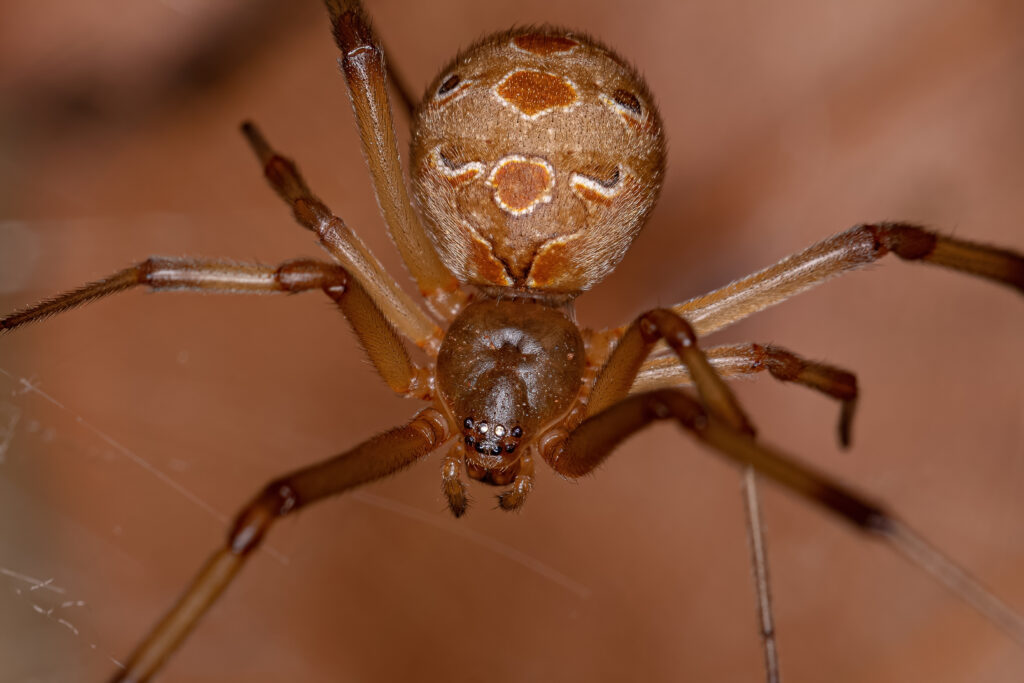
Another one of the most dangerous and venomous spiders in San Joe is the brown widow, which appeared in California in the 2000s.
©iStock.com/ViniSouza128
During the early 2000s, brown widow spiders established their presence in California, and now, these spiders can be spotted in San Jose.
Setting it apart from the distinct black and red design of its cousin, the black widow, the brown widow sports a combination of tan and brown colors accentuated by black patterning. Adult females often feature a top-down stripe on their abdomen, complemented by three angled lines on each side.
Fully grown female brown widows, with their legs outstretched, measure between 1 and 1.5 inches, while males are generally smaller.
Brown widows have a varied diet, including crickets, flies, ants, beetles, mosquitoes, roaches, and other common insects. They typically weave their webs in hidden, shielded areas around homes or within bushy plants with branches.
While the venom of a brown widow is comparable in strength to that of a black widow, they likely release a smaller amount, making their bites less harmful. Known for their timid nature, brown widows usually steer clear of human interactions. Female spiders, in particular, are not confrontational; they’d rather retreat or stay motionless.
5. Black-Footed Yellow Sac Spider (Cheiracanthium inclusum)

While yellow sac spiders prefer residing outdoors, these venomous spiders may venture into your San Jose home in colder weather.
©Rainer Fuhrmann/Shutterstock.com
Yellow sac spiders are found across the nation, and San Jose is no exception.
These spiders typically are yellow, though their color can shift to shades of tan, light brown, or even a pale green based on their surroundings and what they eat. A distinct brown line traces the length of their abdomen, marking the region above their heart. Equipped with long and pointed fangs, they can easily bite through human skin.
In terms of size, a yellow sac spider’s body usually measures between 1/4 to 3/8 of an inch.
Unlike many spiders that rely on webs to ensnare their prey, yellow sac spiders actively pursue their meals. Their diet includes insects, including garden pests, fellow spiders (even those larger than themselves, such as hobo spiders), potential mates, and occasionally their own eggs!
While these spiders generally favor outdoor habitats, they may venture into homes and other structures, even reproducing within, especially in colder weather.
Bites from the yellow sac spider can occasionally result in severe allergic reactions, including anaphylactic shock. A rarer yet concerning effect of their bite is tissue decay. This is because their venom contains cytotoxin, which can cause necrosis at the bite site.
Non-Venomous or Non-Dangerous Spiders in San Jose
There is nothing to fear about the following spiders, as they do not pose any serious threat to humans.
6. Barn Funnel Weaver (Tegenaria domestica)
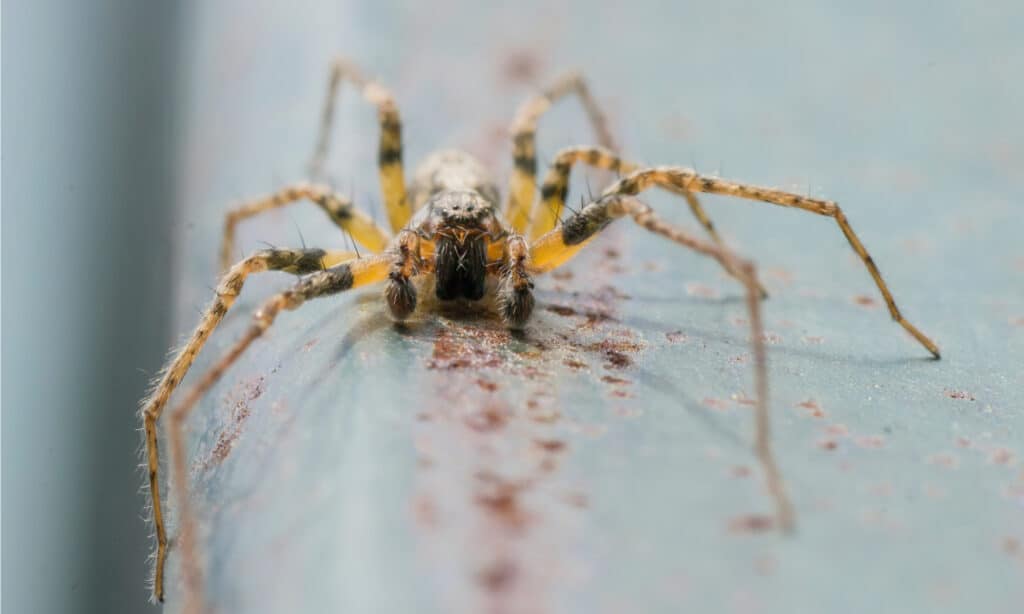
The barn funnel weaver is a beneficial spider that can prey on unwanted insects using their funnel-like webs.
©Korovko Gleb/Shutterstock.com
First on the list of non-venomous, or rather, non-dangerous, spiders crawling in San Jose is the barn funnel weaver.
This spider’s head and thorax are reddish-brown, highlighted with soft-yellow hairs and two light-gray linear markings. Its abdomen varies from a pinkish hue to a light flesh tone and is decorated with a mix of gray and black patches. Its legs, covered in spines, feature subtle light gray bands near the tips.
Female barn funnel weavers typically measure between 0.30 and 0.45 inches in body length, while their male counterparts range from 0.24 to 0.35 inches.
These spiders are quite beneficial as they primarily prey on other unwanted insects. They are known for their unique funnel-like webs, which they craft both inside and outside homes. Beyond buildings, they also inhabit natural settings like hollow trees and caves.
The venom of the barn funnel weaver is only lethal to its prey and poses no threat or danger to humans.
7. Common House Spider (Parasteatoda tepidariorum)
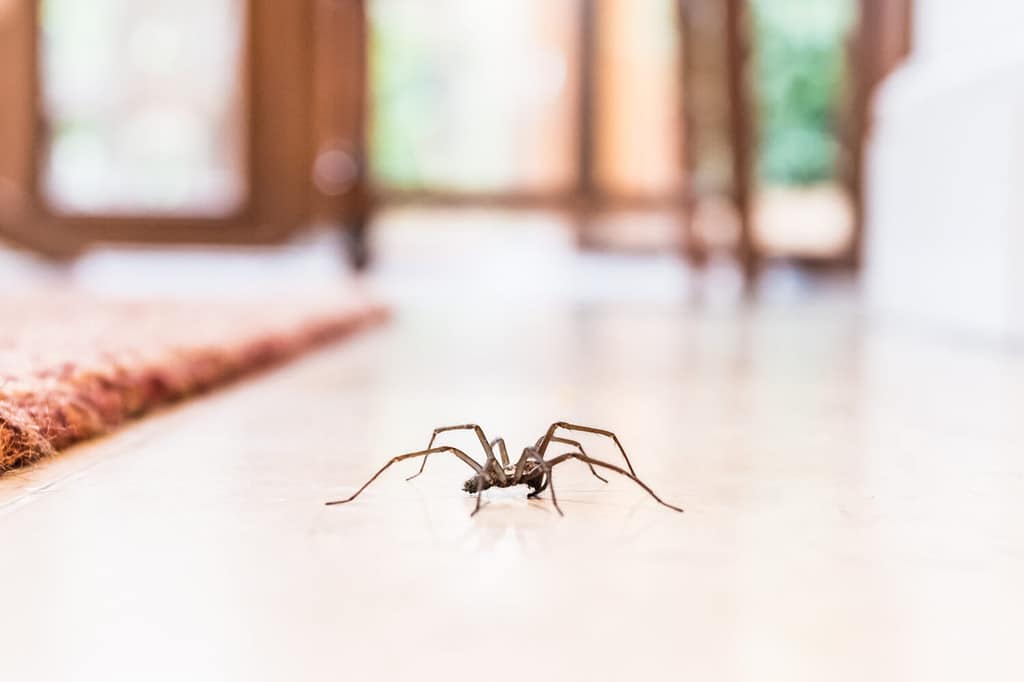
One of the most common spider species you’ll come across in San Jose is the common house spider.
©Christine Bird/Shutterstock.com
Among the spiders you’re likely to encounter in San Jose homes is the common house spider.
This spider typically has a brown coloration, though some might display white or brown patterns on their abdomen. Interestingly, male spiders’ legs show an orange shade, whereas those of females are more yellowish. A distinguishing feature of this spider is the dark bands on its legs.
Measuring less than a quarter-inch in length, these spiders are petite. Notably, the females are slightly bigger than the males.
These spiders are carnivorous by nature, preying on various household pests like flies, ants, moths, fleas, earwigs, cockroaches, and mosquitoes.
Common house spiders are adaptable and make their homes in diverse places. They’re found in gardens, yards, basements, attics, and various other structures humans build.
Despite having venom glands, common house spiders don’t pose a threat to humans. Their venom affects their prey but is generally harmless to people. Furthermore, their fangs are very small.
8. Woodlouse Spider (Dysdera crocata)

Woodlouse spider
bites may hurt at first, but these spiders are actually non-venomous!
©Macronatura.es/Shutterstock.com
The woodlouse spider can be found in regions stretching from New England to California, spanning areas such as Georgia in between.
Recognizing this spider is easy. It boasts a sleek, glossy body featuring a sizable pinkish-gray abdomen, coupled with a reddish head and matching legs. Its striking jaws set it apart. Mature woodlouse spiders differ in size: while females average around a half-inch, males are slightly over a quarter-inch long.
Uniquely, this spider’s sturdy jaws have evolved to puncture the hard exterior of woodlice, which are their sole prey. Rather than creating webs, they prowl during nighttime hours, exploring warm, moist areas to locate wandering woodlice and grasp them with their front-facing jaws.
Unlike many spiders, the woodlouse spider doesn’t weave a web to trap its meals. Its preferred surroundings are moist spots like under rocks, flower pots, tree bark, or rotting wood. They’re often spotted in gardens, parks, forests, and occasionally, damp basements.
While their prominent fangs can be intimidating, these spiders are harmless. They might attack if provoked, but their bite isn’t harmful to humans as they lack venom. And while the bite itself may be painful at first, the pain will subside fairly quickly!
9. California Ebony Tarantula (Aphonopelma eutylenum)
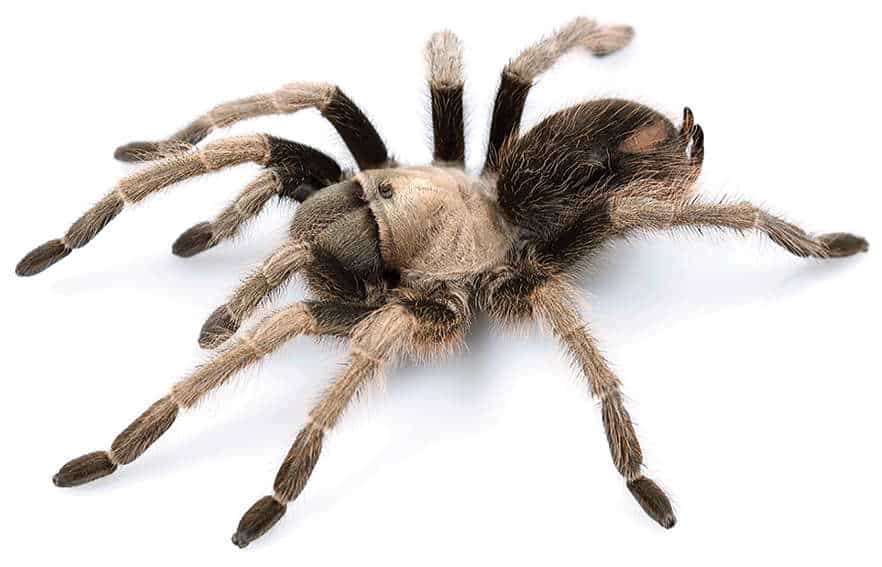
A tarantula spider species you’ll come across in San Jose is the California ebony tarantula, which is not likely to hurt you.
©Chris A. Hamilton, Brent E. Hendrixson, Jason E. Bond / Creative Commons – License
In the San Jose area, the California ebony tarantula is frequently observed.
Showing a variety of brown shades, from pale beige to deep brown and blackish hues, this tarantula is easily recognizable. While mature females can boast a leg span of about 5 inches and have a lifespan reaching 25 years, males mature in about 8 to 12 years and then depart their burrows to seek a partner.
Their diet primarily consists of insects with soft bodies, like crickets, flies, cockroaches, and worms. Being loners, these tarantulas make their homes in ground burrows and are sometimes found among rocks. Their favored habitats include dry, grassy hills and woods rich in oak trees.
Known for its gentle nature, this tarantula isn’t harmful to humans. Although they produce venom like all spiders, it’s mainly effective on smaller creatures to help them secure their meals. However, if you are targeted, the bite will feel like a bee sting and is not dangerous as the venom is relatively weak.
10. Bold Jumping Spider (Phidippus audax)

Both beautiful and terrifying at first glance, the bold jumping spider is a common resident of San Jose.
©Brett Hondow/Shutterstock.com
One of the frequently spotted jumping spiders in San Jose is the bold jumping spider. It is also one of the most common jumping spiders across North America.
Characterized by their fuzzy appearance, typical of most jumping spiders, bold jumpers have a primarily black body. Distinctive white bands adorn their legs, with unique white patterns on their heads and a white triangular mark, accompanied by a pair of dots, on their abdomens. Notably, an eye-catching metallic green hue graces their chelicerae, especially in males.
Impressively, these spiders can leap up to 10 to 50 times their own body size, which varies between 1/4 and 5/8 of an inch. Females are a bit larger compared to males.
Acting as lone predators, bold jumping spiders rely on their sharp vision to pursue and ambush their meals. Their diet encompasses a mix of insects like caterpillars, dragonflies, and grasshoppers, as well as other spiders.
They adapt to various landscapes, from grassy areas and chaparrals to forests and farmlands. Due to their adaptability, they’re one of the most commonly seen spiders residing near human habitats.
Despite their intimidating looks, these jumping spiders pose no threat. They’re harmless and won’t harm humans.
Summary of the Spiders Crawling Around San Jose
| Number | Spider | Dangerous? |
|---|---|---|
| 1. | Western Black Widow | Yes |
| 2. | Noble False Widow | Yes |
| 3. | Desert Recluse | Yes |
| 4. | Brown Widow | Yes |
| 5. | Yellow Sac Spider | Yes |
| 6. | Barn Funnel Weaver | No |
| 7. | Common House Spider | No |
| 8. | Woodlouse Spider | No |
| 9. | California Ebony Tarantula | No |
| 10. | Bold Jumping Spider | No |
The photo featured at the top of this post is © iStock.com/ViniSouza128
Thank you for reading! Have some feedback for us? Contact the AZ Animals editorial team.






